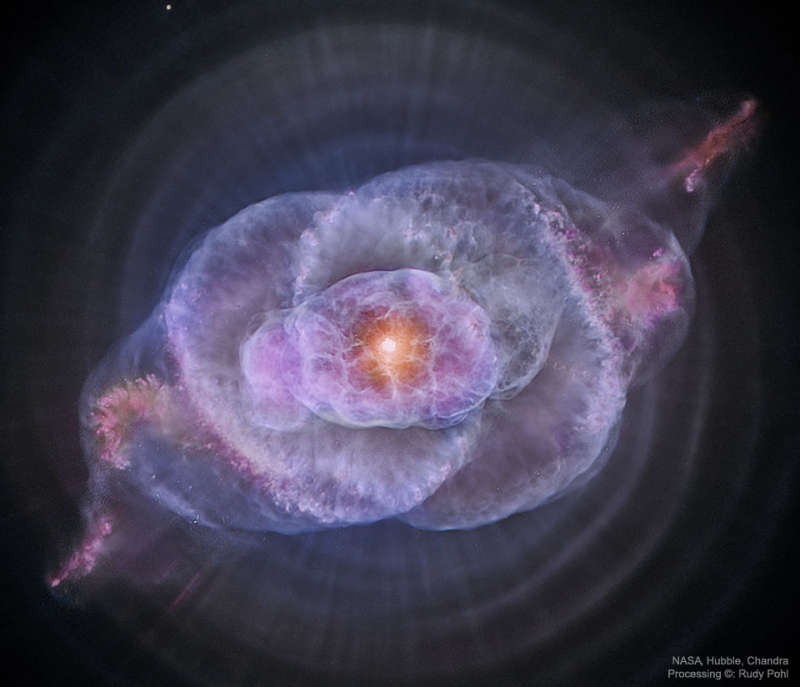Credit & Copyright: NASA,
ESA,
Hubble Legacy Archive;
Chandra X-ray Obs.;
Processing & Copyright: Rudy Pohl
Explanation:
To some it looks like a cat's eye.
To others, perhaps like a giant cosmic
conch shell.
It is actually one of brightest and most highly detailed
planetary nebula known,
composed of gas expelled in the brief yet
glorious phase near the end of life of a Sun-like star.
This nebula's dying central star may have produced the outer circular
concentric shells
by shrugging off
outer
layers in a series of regular convulsions.
The
formation of the beautiful, complex-yet-symmetric
inner structures,
however, is not well understood.
The
featured image is a composite of a digitally sharpened
Hubble Space Telescope image with
X-ray light
captured by the orbiting
Chandra Observatory.
The exquisite floating space statue spans over half a
light-year across.
Of course,
gazing into this Cat's Eye,
humanity may well be seeing
the fate of our sun, destined to enter its own
planetary nebula
phase of evolution ... in about 5 billion years.
Processing & Copyright: Rudy Pohl
APOD in world languages:
Arabic,
Bulgarian,
Catalan,
Chinese (Beijing),
Chinese (Taiwan),
Croatian,
Czech,
Dutch,
French,
French (Canada),
German,
Hebrew,
Indonesian,
Japanese,
Korean,
Montenegrin,
Polish,
Russian,
Serbian,
Slovenian,
Spanish,
Taiwanese,
Turkish,
Turkish,
and
Ukrainian
1999 2000 2001 2002 2003 2004 2005 2006 2007 2008 2009 2010 2011 2012 2013 2014 2015 2016 2017 2018 2019 2020 2021 2022 2023 2024 2025 |
Январь Февраль Март Апрель Май Июнь Июль Август Сентябрь Октябрь Ноябрь Декабрь |
NASA Web Site Statements, Warnings, and Disclaimers
NASA Official: Jay Norris. Specific rights apply.
A service of: LHEA at NASA / GSFC
& Michigan Tech. U.
|
Публикации с ключевыми словами:
NGC 6543 - Cat's Eye Nebula - туманность Кошачий глаз
Публикации со словами: NGC 6543 - Cat's Eye Nebula - туманность Кошачий глаз | |
См. также:
Все публикации на ту же тему >> | |
